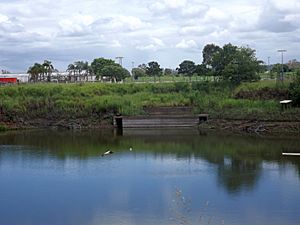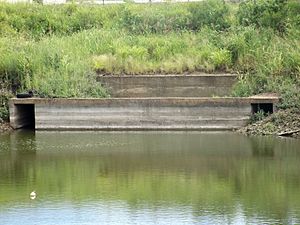Acacia Ridge Air Raid Shelter facts for kids
Quick facts for kids Acacia Ridge Air Raid Shelter |
|
|---|---|

Air Raid Shelter and inundated quarry
|
|
| Location | 174 Mortimer Road, Acacia Ridge, City of Brisbane, Queensland, Australia |
| Design period | 1939 - 1945 (World War II) |
| Built | c. 1942 - c. 1943 |
| Official name: Acacia Ridge Air Raid Shelter | |
| Type | state heritage (built) |
| Designated | 6 April 2005 |
| Reference no. | 602487 |
| Significant period | 1942-1943 (fabric) 1940s (historical) |
| Significant components | wall/s - blast |
| Builders | Allied Works Council |
| Lua error in Module:Location_map at line 420: attempt to index field 'wikibase' (a nil value). | |
The Acacia Ridge Air Raid Shelter is a special historical building. It is located at 174 Mortimer Road, Acacia Ridge, City of Brisbane, Queensland, Australia. This shelter was built around 1942 to 1943 by the Allied Works Council. It was designed to protect people during air raids in World War II. Today, it is recognized as an important heritage site. It was added to the Queensland Heritage Register on April 6, 2005.
Contents
A Shelter from World War II
This air raid shelter is built into the side of an old quarry. This quarry is known as Archerfield Quarry or Carr's Quarry. It is found in the Mortimer Road Reserve in Acacia Ridge.
Before World War II, the Archerfield area was mostly undeveloped. It was used for farming and grazing animals. In 1929, the government took some land here. They built an airfield called Archerfield Aerodrome. This airfield became very important during World War II. It was a base for Australian, British, American, and Dutch air forces.
Why Air Raid Shelters Were Needed
World War II became a global conflict after December 7, 1941. On this day, Japan attacked the American fleet at Pearl Harbor in Hawaii. Soon after, Japanese forces bombed Darwin, Australia. Many Australians were also captured when Singapore fell. These events made Australia prepare for a possible invasion. Queensland became a key support base for the war in the Pacific. Many Australian and American soldiers arrived. They needed new buildings and facilities quickly.
Protecting Soldiers at Archerfield
American soldiers were based at Archerfield. A military camp called Camp Buckley was set up nearby. Large igloo hangars were built north of the quarry. A special path for planes, called a taxiway, ran close to the quarry. This path connected the hangars to the main airfield.
The air raid shelter was built to protect military personnel. These were the soldiers and staff working near the airfield. Old photos show that the quarry's water level was lower back then. The shelter was built on a rock shelf. It looked like a freestanding building. Over time, earth has moved around it. This makes it look like it's built into the quarry wall now.
The shelter had an outer wall for extra protection. This wall had entrances to two tunnels. These tunnels led into the main bunker. Records from January 1943 mention a "bomb proof building." This building was for United States Air Corps Operations. It was near the American camp. This might be the shelter in the quarry.
Discoveries After the War
After the war, military items were dumped into the quarry. In 1963, the Brisbane City Council bought the area. They planned to use it for recreation. In 1992, some historians partially drained the quarry. They found many military items. These included World War II machine guns, ammunition, and aircraft parts.
This draining also allowed them to look inside the shelter. They found that the two entrance tunnels are about 20 feet (6 meters) long. These tunnels lead to doorways into the main bunker. They also found parts of thick wooden sliding doors. There were also three one-foot wide holes in the bunker's ceiling. Today, the water level in the quarry is too high to go inside the shelter.
What the Shelter Looks Like
The Acacia Ridge air raid shelter is a concrete bunker. It is shaped like a rectangle. It sits on a rock shelf cut into the north side of the old quarry.
The part of the bunker you can see now has two concrete walls. There is a space between these two walls. They run along part of the quarry face. Then they turn into the quarry wall. The outer wall is lower and has concrete supports. It has rectangular openings at each end. The inner bunker wall is shorter but taller. It does not have any visible openings. Only the top of the outer wall is visible above the water. Plants and trees also hide the main bunker.
Why This Place is Important
The Acacia Ridge Air Raid Shelter is listed on the Queensland Heritage Register. This means it is a very important historical site. It was listed on April 6, 2005.
Part of Queensland's History
This shelter shows how Queensland prepared for World War II. It was part of the Air Raid Precaution activities in Brisbane. It was built to protect soldiers from the Archerfield aerodrome. It reminds us of how the war affected Queensland.
A Rare Survivor
Many air raid shelters were built in Queensland during World War II. However, not many of them still exist today. This shelter was built for military personnel. It also still has its outer protective wall. This makes the Acacia Ridge shelter quite rare and special.
Showing What a Military Shelter Is Like
The shelter is very strongly built. Its location near a military base is also important. These features show us what a World War II military air raid shelter was typically like.


